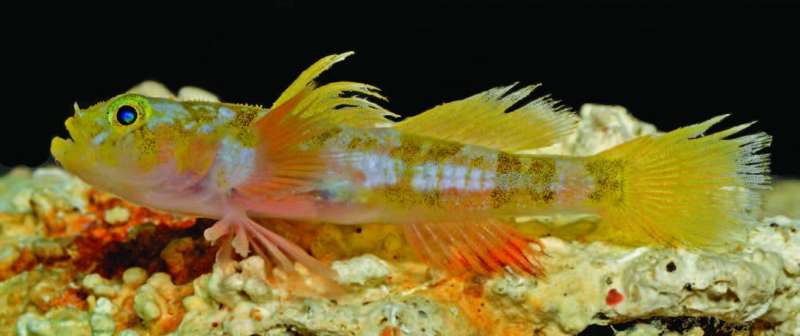The Godzilla goby is the latest new species discovered by the Smithsonian DROP project

As part of the Deep Reef Observation Project (DROP), initiated by the Smithsonian Institution, a new goby fish species was discovered in the southern Caribbean. Living at depths greater than conventional SCUBA divers can access, yet too shallow to be of interest for deep-diving submersibles, the fish will now be known under the common name of the Godzilla goby.
Its discoverers Drs Luke Tornabene, Ross Robertson and Carole C. Baldwin, all affiliated with the Smithsonian Institution, have described the species in the open access journal ZooKeys.
Formally called Varicus lacerta, the species name translates to 'lizard' in Latin and refers to the reptilian appearance of the fish. Its prime colors are bright yellow and orange, while the eyes are green.
The new goby also has a disproportionately large head and multiple rows of recurved canine teeth in each jaw. This is also why the research team has chosen the common name of the Godzilla goby.
Apart from its lovely coloration, the new fish stands out with its branched, feather-like pelvic-fin rays and the absence of scales.
The scientists caught the Godzilla goby thanks to the manned submersible Curasub, which had already helped in discovering several species over the course of the project. Last year, Drs Ross Robertson and Carole Baldwin had another new goby published in ZooKeys. That time, they even named it after the submersible. Earlier this year, the DROP team also described nine additional new species, many of which were collected by the Curasub.

The manned submersible Curasub reaches depths up to 300 m in search of tropical marine fishes and invertebrates. As a result, it provides new information on the fauna that inhabits poorly studied deep-reef ecosystems.
The sub relies on two hydraulic arms, one equipped with a suction hose, and the other designed to immobilize the fish with an anaesthetizing chemical. That way, not only do the researchers gather live specimens, which once collected, are deposited into a vented acrylic cylinder attached to the outside of the sub, but also individuals suitable for critical DNA analyses.
More information: Luke Tornabene et al, Varicus lacerta, a new species of goby (Teleostei, Gobiidae, Gobiosomatini, Nes subgroup) from a mesophotic reef in the southern Caribbean, ZooKeys (2016). DOI: 10.3897/zookeys.596.8217
Journal information: ZooKeys
Provided by Pensoft Publishers





















